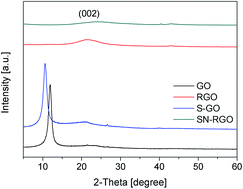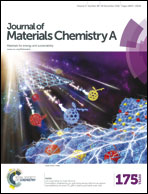A novel approach of binary doping sulfur and nitrogen into graphene layers for enhancing electrochemical performances of supercapacitors†
Abstract
In this paper, we present a novel route to prepare sulfur and nitrogen co-doped reduced graphene oxide, in which, two main procedures – the preparation of a sulfur doped graphite intercalation compound (S-GIC) and the construction of the sulfur and nitrogen co-doped reduced graphene oxide (SN-RGO) – are included. The loading of sulfur and nitrogen in SN-RGO, which is tracked by X-ray photoelectron spectroscopy, is 1.47 and 3.90 at%, respectively. SN-RGO possesses an almost two times higher specific surface area (SSA) than RGO and a narrow pore size distribution. Electrochemical investigations demonstrate that SN-RGO exhibits an outstanding capacitive performance, its specific capacitance at the scan rate of 5 mV s−1 in a 6 M KOH aqueous electrolyte being up to 402.4 F g−1, which is, to the best of our knowledge, among the highest values so far reported for S/N co-doped carbon materials. Furthermore, SN-RGO also exhibits an excellent cycling stability (almost 95% specific capacitance being retained even after 10 000 cycles). This work suggests that constructing doped graphene-based materials by using the intercalated substances among the graphite layers as the dopant sources can be considered as a promising strategy for the development of high performance electrodes for supercapacitors.


 Please wait while we load your content...
Please wait while we load your content...